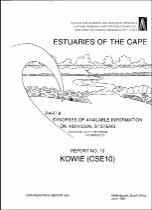JavaScript is disabled for your browser. Some features of this site may not work without it.
- ResearchSpace
- →
- Archives collection
- →
- Open Access Reports
- →
- View Item
| dc.contributor.author |
Estuarine and Coastal Research Unit, ECRU

|
|
| dc.date.accessioned | 2009-06-24T09:04:08Z | |
| dc.date.available | 2009-06-24T09:04:08Z | |
| dc.date.issued | 1982-06 | |
| dc.identifier.citation | CSIR, Estuarine and Coastal Research Unit. 1982. Kowie (CSE10). Report 10 of the Estuaries of the Cape, Part 2: Synopses of available information on individual systems series. Stellenbosch: CSIR (CSIR Research Report 409) | en |
| dc.identifier.isbn | 0 7988 1812 3 | |
| dc.identifier.uri | http://hdl.handle.net/10204/3451 | |
| dc.description | Estuaries of the Cape | en |
| dc.description.abstract | A detailed account of the history of the Kowie estuary and the attempts to develop a harbour at the mouth of the river are given in the “Basket Work Harbour”. (Turpin, 1964). As far as could be ascertained, the river has always been known as the Kowie River. The settlement established at the mouth of the river in 1821 was originally called Port Kowie. This was changed to Port Frances in 1825 in honour of the wife of Colonel Henry Somerset who was then in charge of the military forces on the Eastern Frontier. In 1860 the name of the town was changed once again, to Port Alfred to honour Prince Alfred, Duke of Edinburg who was visiting the Frontier at that time. When the settlement was first established at the mouth of the river, the estuary “consisted of one vast swampy region bounded on the east and west by the hills today known as the East and West Banks. When the tide receded it left exposed a number of sandbanks or islands, and the main outlet to the sea was under the eastern hill, exactly opposite the flats to where it is at present. | en |
| dc.language.iso | en | en |
| dc.publisher | CSIR, National Research Institute for Oceanology | en |
| dc.relation.ispartofseries | CSIR Research Report Number | en |
| dc.relation.ispartofseries | 409 | en |
| dc.relation.ispartofseries | CSIR NRIO Number | en |
| dc.relation.ispartofseries | 10 | en |
| dc.relation.ispartofseries | CSIR Estuary Index Number | en |
| dc.relation.ispartofseries | CSE 10 | en |
| dc.subject | Abiotic characteristics | en |
| dc.subject | Catchment characteristics | en |
| dc.subject | Flora | en |
| dc.subject | Fauna | en |
| dc.subject | Oceanology | en |
| dc.subject | NRIO | en |
| dc.subject | National Research Institute for Oceanology | en |
| dc.subject | CSIR | en |
| dc.subject | Council for Scientific and Industrial Research | en |
| dc.subject | Coastal research | en |
| dc.subject | Kowie estuary | en |
| dc.subject | Cape estuaries | en |
| dc.title | Kowie (CSE10) | en |
| dc.type | Report | en |
| dc.identifier.apacitation | Estuarine and Coastal Research Unit, E. (1982). <i>Kowie (CSE10)</i> (CSIR Research Report Number). CSIR, National Research Institute for Oceanology. Retrieved from http://hdl.handle.net/10204/3451 | en_ZA |
| dc.identifier.chicagocitation | Estuarine and Coastal Research Unit, ECRU <i>Kowie (CSE10).</i> CSIR Research Report Number. CSIR, National Research Institute for Oceanology, 1982. http://hdl.handle.net/10204/3451 | en_ZA |
| dc.identifier.vancouvercitation | Estuarine and Coastal Research Unit E. Kowie (CSE10). 1982 [cited yyyy month dd]. Available from: http://hdl.handle.net/10204/3451 | en_ZA |
| dc.identifier.ris | TY - Report AU - Estuarine and Coastal Research Unit, ECRU AB - A detailed account of the history of the Kowie estuary and the attempts to develop a harbour at the mouth of the river are given in the “Basket Work Harbour”. (Turpin, 1964). As far as could be ascertained, the river has always been known as the Kowie River. The settlement established at the mouth of the river in 1821 was originally called Port Kowie. This was changed to Port Frances in 1825 in honour of the wife of Colonel Henry Somerset who was then in charge of the military forces on the Eastern Frontier. In 1860 the name of the town was changed once again, to Port Alfred to honour Prince Alfred, Duke of Edinburg who was visiting the Frontier at that time. When the settlement was first established at the mouth of the river, the estuary “consisted of one vast swampy region bounded on the east and west by the hills today known as the East and West Banks. When the tide receded it left exposed a number of sandbanks or islands, and the main outlet to the sea was under the eastern hill, exactly opposite the flats to where it is at present. DA - 1982-06 DB - ResearchSpace DP - CSIR KW - Abiotic characteristics KW - Catchment characteristics KW - Flora KW - Fauna KW - Oceanology KW - NRIO KW - National Research Institute for Oceanology KW - CSIR KW - Council for Scientific and Industrial Research KW - Coastal research KW - Kowie estuary KW - Cape estuaries LK - https://researchspace.csir.co.za PY - 1982 SM - 0 7988 1812 3 T1 - Kowie (CSE10) TI - Kowie (CSE10) UR - http://hdl.handle.net/10204/3451 ER - | en_ZA |






